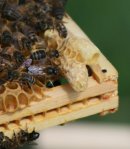Having found the queen cells in my number one hive it was time to try and split the bees into a new hive. The idea behind this is that all the flying bees (the foragers) and the original queen end up in an empty hive but located in the same position as the original hive. This is meant to trick them into thinking that they have already swarmed and they should get down to laying new eggs, building a new colony and collecting new stores.
The second hive has all the hive bees (workers that have not yet started flying to collect pollen and nectare) and is setup in a new position near to the first hive. When the new queen emerges she will leave the hive to go on her mating flights, then will return and remain in the hive – for up to four years – laying eggs.
Sounds simple! Having read about the theory it was time to test my nerve and attempt to split the hive. I should add at this point that I had never been stung by a bee before and had no idea if I had a major allergy to the stings … and my bees are located in the middle of no-where so most of the work I do there is quite isolated.
Normally you would just find the queen before making the split, but the hive was very crowded, due to a sudden cold spell, and many of the flying bees that would normally be out foraging were also at home – finding one queen amongst 50 – 60,000 workers is never an easy task but it has to be done. I checked and re-checked all the frames but had no joy in finding her.
Time for plan B: I set up the new empty hive on a floor, with undrawn foundation in the position of the old hive. I removed the frames of bees from the old hive, one at a time and shook and brushed the bees into the new hive, very gently so as not to damage the old queen. This involved 22 frames of bees and to say they objected is an understatement.
They say that you are not really a beekeeper until you have been stung – well I became a beekeeper that day!
Once I had shaken the bees into the new hive I placed a queen excluder (a sheet of metal with slots stamped through it that only the workers can fit through, not the larger queen) over the top. Then I placed the now empty original hive over the top and put the lid back on. The idea here is that over the next hour or so the worker bees on ‘nurse’ duty will all climb up in the hives to cover the frames with eggs, larva and capped brood to feed and maintain the correct temperature in the hive (shivering to create heat or fanning air to cool it down). After the hour you move the top boxes only to the new position – this has a un-hatched queen cells and the non-flying bees in. Any flying bees left in this hive will leave the next day on their foraging duties but will return to the location of the original hive, to join the old queen and help build the new colony up there. It was exhausting work, I was stung about 7 times through my protective clothing but at least discovered that not only was I not allergic I hardly even noticed with no itching, redness or swelling (you do feel them going in though – ouch!).
After spliting the hives it is neccesary to feed sugar syrup to both hives. The original queen and bees use theirs to boost wax production for drawing out the foundation. The new hive has no flying bees to start with so needs food to feed the workers and the young brood whilst the queen gets ready to emerge.
You pretty much leave the hives alone now so as not to disturb, or damage, the new queen until she is hatched, mated and laying …. well thats was my plan anyway – but not the bees!





